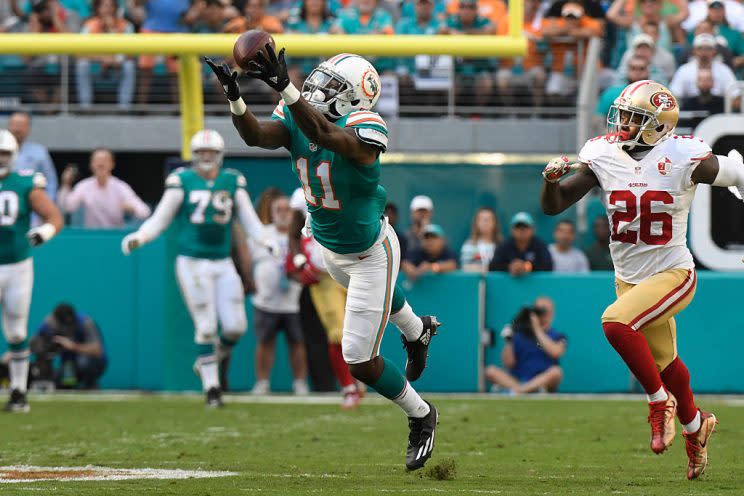Juggernaut Index, No. 20: Dolphins offer Jay Ajayi, lesser fantasy pieces

The Miami Dolphins broke a seven-year playoff drought in Adam Gase’s first season as head coach, bouncing back impressively from a 1-4 start. The team was eviscerated by Pittsburgh in the Wild Card round, but that shouldn’t diminish the achievement of qualifying for the postseason. An optimistic fan would say this is an ascending franchise led by a clever young coach, anchored by a foundational running back.
[Now’s the time to sign up for Fantasy Football! Join for free]
However, a more pessimistic observer might point out that the Dolphins actually finished with a negative point differential last season (-17) and they were fortunate to pull off a series of narrow wins against terrible teams. But [profane] those guys. Let’s not focus on the doubters just now. The fact is, it’s damn tough to win 10 games in the NFL, regardless of a team’s strength of schedule. Miami deserves plenty of credit.
Quarterback Ryan Tannehill established new career bests in completion percentage (67.1), yards per attempt (7.7), passer rating (93.5) and touchdown rate (4.9) last season, but to some extent those numbers were a product of game script. Gase kept his QB in game-manager mode for most of the season, particularly after Miami’s dreadful start. Tannehill attempted only 3.2 deep passes per game last year, one of the lowest rates in the league. The offense’s conservatism didn’t do much to prevent turnovers; Tannehill was intercepted on a career worst 3.1 percent of his attempts. And his season ended in Week 14 due to a partially torn ACL and sprained MCL.
Tannehill’s season ended in Week 14 due to a partially torn ACL and sprained MCL, but he avoided surgery and, according to Gase, he now “moves around fine.” He should be good to go when camp opens.
The essential problem with Tannehill is that, at this stage, he’s well entrenched in the Schaub Zone — or, if you prefer, the Alex Smith Zone. He’s clearly good enough to win regular season games at the controls of a talented offense, yet he’s pretty clearly not good enough to elevate a team from playoff-caliber to Super Bowl challenger. It’s an issue. For fantasy purposes, Tannehill remains only a streaming option for standard league players. He’s the guy you might consider when your usual starting QB is on a bye.
If you want to make the case that Tannehill can make a sudden jump in value, you should build it around the fact that Miami offers a quality receiving corps and year-to-year continuity on offense.
Another year, another round of DeVante Parker hype
Yup, ‘fraid so. Parker possesses size, speed and obvious athletic talent, and he enters his third pro season having been hyped and re-hyped. He made a respectable statistical jump from year one (26-494-3) to year two (56-744-4), and he’s America’s sleeper entering 2017. Miami’s coaches and beat writers have promoted him endlessly, as if they were trying to build up his fantasy trade value. Parker reportedly dedicated himself to better habits, both on and off-field. Fantasy owners aren’t exactly paying an expectant price, at least in Yahoo leagues (ADP 100.7), so he’s a player to covet in the mid-rounds. If his targets were to increase from 90 last year to, say, 120 or 125, he’d almost certainly produce a 1000-yard, 6-TD season. That’s WR2-level performance at the cost of a WR4.

If Parker is going to take another step forward, then it will likely happen at the expense of Kenny Stills. It’s tough to imagine Stills repeating his 2016 touchdown total (9) on volume similar to what he saw last season (81 targets). He’s a big-play receiver tied to a small-play passing game, which hardly seems great. No player consistently converts 21 percent of his catches into touchdowns. He can’t be drafted anywhere near his positional finish last season.
Jarvis Landry remains the guy with the most significant workload in this receiving corps, of course. Landry is a legend among the crusty old-timers who still think PPR is a good idea. (We’ve already had that convo around here. It is settled.) He saw 131 targets last season — a decrease from 2016 (165), but still plenty — and finished his season with 94 catches for 1136 yards. He gained the second-most yards after catch among all receivers (612), for what it’s worth. Landry was largely ignored near the goal line, however, seeing just nine red-zone targets and only four inside the 10-yard line. Nothing new there. He’s a player of interest in any format, but the limited TD ceiling clearly hurts him in standard scoring setups.
There’s no fourth wide receiver on the Dolphins’ roster who needs to be targeted in fantasy leagues of any size, so let’s not list the entire crew. Second-year wideout Leonte Carroo is the presumptive No. 4 entering camp; he caught three balls last year. Woo.
Miami acquired tight end Julius Thomas during the offseason and he obviously has a terrific history under Gase, dating back to the Denver days. Coaches have talked up Thomas’ role in a big way…
Clyde Christensen asked what Julius Thomas can add to Dolphins offense: “10, 12 touchdowns. That’s what he added in Denver.”
— Armando Salguero (@ArmandoSalguero) May 6, 2017
…but let’s not pretend he’s stepping into the exact situation he enjoyed with the Broncos. On Tannehill’s best day, he can’t deliver even a bad impression of a vintage Peyton Manning. But Thomas will nonetheless have a role near the goal-line and he’s generally ignored in Yahoo drafts (ADP 128.0). Not a bad late option for those who won’t invest in the early round tight ends. Beware the injury history with Thomas; he’s never appeared in more than 14 games in any season.
OK, what’s the potential for Jay Ajayi?
Ajayi was a revelation last season, even for those of us who kinda/sorta liked him entering the year. He rushed for 1272 yards and eight spikes, averaging 4.9 YPC, and he basically did it all in 12 games. Ajayi was merely a rotational runner until the calendar flipped to October. From the moment he assumed the lead role in Miami’s backfield, he was beastly. Ajayi gashed the Steelers for 204 rushing yards in Week 6, prompting the global community of fantasy experts to declare that A) he was a must-add player, but B) he’d just had a career day, never to be duplicated. The following week, he ran for 214 yards against Buffalo.
Ultimately, Ajayi would finish his season with three games of 200-plus yards, becoming just the fourth player in NFL history to accomplish the feat. You’ve probably heard of the other three backs: Earl Campbell (1980), O.J. Simpson (1973) and Tiki Barber (2005).

Ajayi ranked second in the league in yards-after-contact per game last year (32.3), behind only Le’Veon Bell (41.4), ahead of Zeke (30.9) and David Johnson (30.4). You’re allowed to fret about the fact that a huge percentage of his total rushing yards were delivered in just three weeks, but, again, the man only served as a featured runner in a dozen games. He topped 70 scrimmage yards eight times last season. He can play. If you like him as a late first-rounder (or a bit earlier), you’ll get no argument from me. He’s begging for a larger workload and Coach Gase is fully on board:
“It’s slowed down for him a lot from where we were last year compared to where we are right now,” Gase said of Ajayi. “The questions he brings up to us are very detailed. We’re really beyond next level questions. They’re really quarterbackish questions. I love the way his intrigue of what’s going on at his position has been outstanding.
“He wants to be a guy that can be counted on for second and third down. He does not want to come off the field. Everyone gets concerned with the amount of carries and his physical style of running and we’ll handle that as we go. But I love the mentality that he has right now. He wants to be a guy that’s relied on right now. He’s our bell cow running back. At the same time he’s our top third-down guy and red area and two-minute guy.”
Don’t try to tell me you’ve seen a more bullish quote from a coach this offseason.
So, to answer the question posed in the subhead above, Ajayi’s potential is 2000 scrimmage yards. His situation is rare. Kenyan Drake and Damien Williams will battle for handcuff duties during the preseason, but neither is a threat to Ajayi’s spot atop the depth chart.
Miami’s O-line seems weak at the guard spots, so a healthy season from three-time Pro Bowl center Mike Pouncey is a must. He’s coming back from a hip malfunction and appears to be on track for the opener.
Any reason to care about Miami’s D/ST?
This team’s early season schedule has some modest fantasy appeal. The Dolphins open with a matchup against Jameis Winston, who threw 18 picks last year, and they face the Jets twice before the end of October. But should we think of Miami’s D as a full-season fantasy asset? Nope, not recommended just yet. This group ranked middle-of-the-pack in both turnovers (25) and sacks (33) in 2016, and they finished No. 29 in yards allowed (382.6 YPG). The team did use its first three draft picks on defensive talent while adding a group of sketchy vets, so it’s not crazy to expect improvement. DT Ndamukong Suh and SS Reshad Jones figure to be the best of Miami’s IDPs.
2016 Offensive Stats & Ranks
Points per game – 22.7 (17)
Pass YPG – 218.8 (26)
Rush YPG – 114.0 (9)
Yards per play – 5.8 (9)
Plays per game – 57.4 (32)
—
Previous Juggernaut Index entries: 32) NY Jets, 31) San Francisco, 30) Cleveland, 29) LA Rams, 28) Baltimore, 27) Chicago, 26) Minnesota, 25) Detroit, 24) Denver, 23) Jacksonville, 22) Buffalo, 21) Philadelphia, 20) Miami



